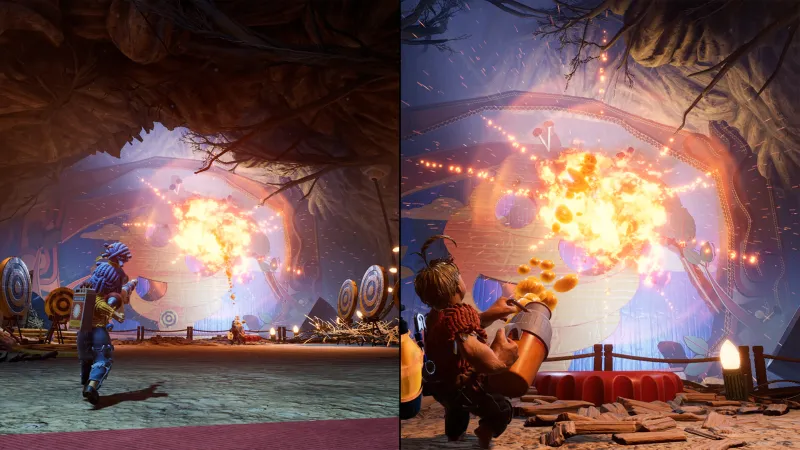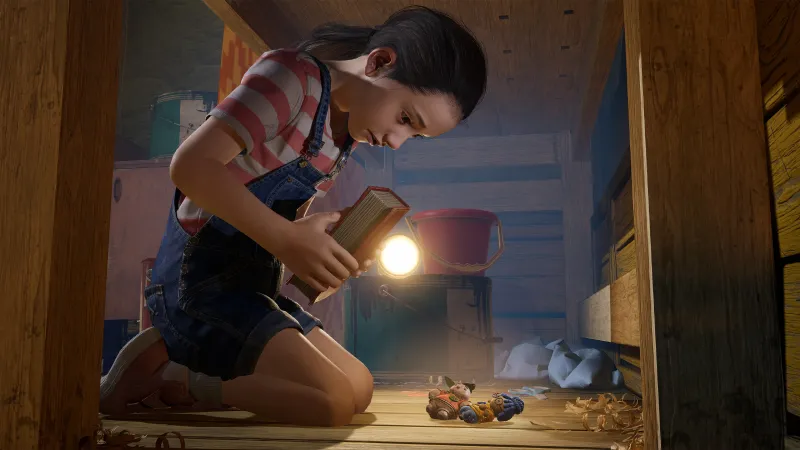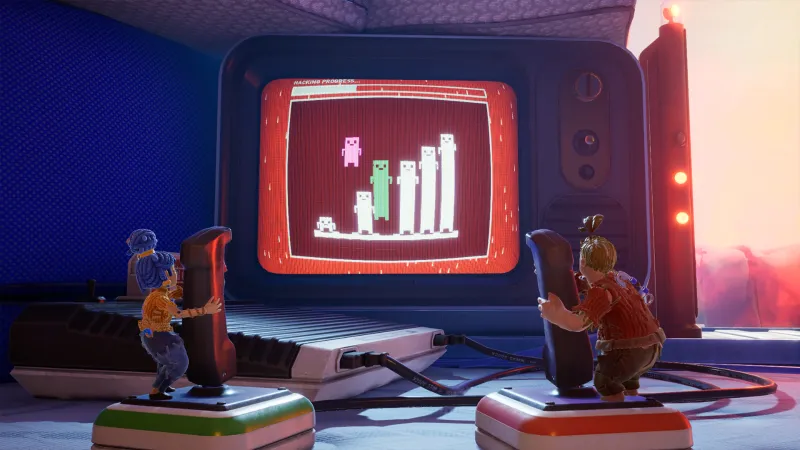

Subscribe today to receive the next issue of Game Informer, featuring the Most Anticipated Games of 2026!
Josef Fares is a passionate man. The filmmaker-turned-game-developer’s first game, Brothers: A Tale of Two Sons, is a remarkable fable about the power of family. While that game’s quality spoke for itself, Fares took to the stage for follow-up A Way Out, memorably taking over Geoff Keighley’s 2017 Game Awards broadcast by addressing the camera and saying, in part, ‘F--- the Oscars!” It was a profane moment, to be sure, but it also showed Fares’ exuberance and natural flair for the outrageous. Hazelight Studios’ upcoming project, It Takes Two, tackles the oddly underrepresented subject of love. And after talking to Fares about the co-op adventure, it’s clear that he has a lot to say about, well, everything.
“Video games are not always about fun; that’s a misconception that many people say, ‘Is this fun?’” Fares says. “The best moments of my life in video games haven’t been about ‘fun.’” The game director and Hazelight founder cites experiences like Journey or moments from the opening sequence in The Last of Us to underscore his point. His own game, Brothers, memorably ends with a powerful moment that clearly isn’t meant to be fun. “Some parts of gaming are fun, but I would say that more, depending on the scene, it should be engaging.”

That’s all to say that It Takes Two starts at a place that is decidedly unfun: the specter of divorce. Cody and May are a married couple who have fallen out of love. Nothing especially heavy has happened, Fares says, but the grind of daily life has worn them down, and they’ve decided that it might be best to go their separate ways. Their young daughter, Rose, is not a fan of the idea.
“She created these two small dolls and she tries, as kids do, to talk to them and try to affect them somehow, and they magically transform into these dolls in this fantasy world,” Fares says. From there, it becomes a journey of discovery, both in how the couple rediscovers what initially brought them together, as well as trying to rediscover how the heck to get back into their regular bodies. They’re joined by an anthropomorphic Book of Love, who acts as a sort of relationship guru. It’s a cute setup, but Fares and his team at Hazelight are using it as a vehicle for pushing narrative and gameplay as close as they can possibly get.
Watch the It Takes Two trailer, and it’s hard not to get whiplash. It introduces the story conceit, and then flashes a string of gameplay clips together at a frantic pace. That kind of editing style is relatively commonplace in game trailers, but it may be closer to It Takes Two’s reality than in many of its contemporaries. Fares recognizes the importance of novelty and surprise in games, and it’s something that Hazelight is leaning into in a big way.
“Because we’re doing a narrative game, every situation has to reflect what goes on in the game,” he says. “So, if the character needs something, it should reflect the gameplay as well. I think in narrative games especially, repetitiveness is super dangerous. Once you have that, you get the feeling sometimes that designers and writers are doing two different games, if you know what I mean.”
He takes a slight detour, saying that he’s not talking about games that rely on repetition, such as ones where the goal is to level up and upgrade your character. That’s another discussion, he says, before sticking in a quick jab: “Because for me, just changing colors and numbers on enemies is just a fake way … I think in 10 years hopefully nobody will do this, just having numbers going up, up, up, up, up.”
Fares believes that for a narrative game to be truly successful, there has to be a strong relationship between the story and what players are doing at any given moment. “Whatever the character is going through, it should reflect the gameplay as well,” he says. “It’s going to be insanely varied. I think we’re going to break some kind of world record in the amount of mechanics that we have.”

The reality of budgets and timelines makes it tricky to fully avoid repetition, but Hazelight’s previous work has shown their willingness to find creative solutions. In A Way Out, for instance, players encounter several obstacles while trying to cooperatively escape from a prison. Rather than have them retrace their steps back every time they run into a locked grate, out-of-reach corridor, or whatever, Fares thought it was important to respect players’ time and have the sequences that introduce a problem transition to the problem-solving phase, as might happen in a movie. That’s one way to avoid repetition. Another is to gleefully overwhelm players with the sheer amount of stuff they can do.
“For instance, we have a level where they need to work on their attraction; as a couple, they’ve lost their attraction,” Fares says. “And that metaphor for attraction is actually a piece of magnet that we break in two so they have sort of a magnetic attraction to each other. And we have another section where they feel like they don’t give each other enough time, as can happen in a relationship.” In that section, Cody can temporarily control time, and May – thinking she’s spread too thin in her life – can make copies of herself. “We tried to marry those two, so they’re connected to their emotional states as well. That’s the way we’re pushing for this game.”
The goal, Fares says, isn’t to introduce mechanics and systems that players are expected to fully commit to and master over hours. Instead, his team wants to deliver new ideas and concepts quickly, by having Cody and May (and players) solve the problems they face on their journey from their shed through the various rooms throughout their home. That journey includes fantastical detours, such as a trip into a snow globe that they purchased together on a vacation. In that instance, Fares says there’s almost like a city within that glass dome. That sensation of never knowing what’s coming next makes for a game that Fares says people won’t be able to put down. “I’m really telling you, that’s a guarantee. I know I sound very cocky all the time, but that’s a guarantee. It’s very important for a narrative game.”
Fares wants people to get together with a friend or partner and enjoy It Takes Two – it can’t be played solo, after all. But he also wants them to finish the game. “I know people came up to me and said, ‘Wow it’s fantastic that 51 percent of players in A Way Out finished the game,’ and they told me that that’s an extremely high percentage number, but actually it saddens me. That means that 49 percent of people didn’t finish it. It’s not something I should be happy about.
“Every journalist right now needs to stop writing replayabilty, because we need to fix the problem that people are not even finishing our games. People are not even finishing the games. Listen to how sick this is: It’s so sick that the developers and publishers are literally focusing on the first piece of the game, because they know that’s what people will play. This is a mass psychosis going on!”
Hazelight’s focus on variety and telling an engaging story that ties into what players are doing is the studio’s way of trying to hook players along through to the closing credits. It’s not delivering open worlds (“I call them ‘open-repetition games,’” Fares jokes), but instead creating highly varied and more directed linear experiences.

It’s a bet that Fares is, characteristically, extremely confident in. Early in our conversation, he makes a statement that is impressively bold: “That’s another thing that I can guarantee you with It Takes Two: It’s impossible, and quote me on this, to get tired of this game. You can put this as the headline. I can literally give 1,000 bucks to anyone who says, ‘Oh, I’m tired of this game now because it doesn’t surprise me.’ One thousand bucks! I guarantee. I’ll give it to everyone who gets tired. But they have to be honest about it.”
Fares’ bombastic confidence is equal parts refreshing and entertaining. But it’s clearly coming from a sincere place. In an industry where focus testing can often shave the edges off a creative enterprise until it’s an inoffensive sphere, Hazelight is aiming to hold firm in its ideas and tell the stories it wants to tell – whether about prison breaks or romantic breakups.
“We do the game we want to do, and then when we take [the] game [to] players to test it, we want them to like the game we’re doing, not adjust the game for what they want,” Fares says. “It’s different. I think that’s very important instead of adjusting the game for the player. They should understand our game, and not the opposite. I guarantee people will love this. For sure. I have no doubt at all. If people don’t like this game, then I don’t know what to do. It would be nuts. I wouldn’t accept it. It’s unacceptable! Then everybody is wrong!” He punctuates the last sentence with an infectious laugh.

It’s hard not to get swept up into Fares’ worldview. He’s charismatic and charming, able to say provocative things without sounding like a complete jackass. In an industry where so many developers seemingly aspire to be film directors, Fares comes to games from the other direction. After spending a decade making feature films in Sweden, he’s turned his creative energy toward the medium he loves. Fares says It Takes Two was inspired by a lifetime of peering at games from the outside.
“It’s almost like a love letter for my love of gaming – especially Nintendo; I’m a big Nintendo fan,” he says. “But it’s time for Nintendo to get some competition.” With that, he cracks himself up completely, looking around for a few seconds, perhaps momentarily taken by surprise by his own good-natured hubris.
